Chess Notes
Edward Winter
When contacting us by e-mail, correspondents are asked to include their name and full postal address and, when providing information, to quote exact book and magazine sources. The word ‘chess’ needs to appear in the subject-line or in the message itself.
| First column | << previous | Archives [172] | next >> | Current column |
11082. Calvi (C.N.s 1827 & 1836)
As reported in C.N.s 1827 and 1836, our collection includes five hardbound volumes of Ignazio Calvi’s Cours d’échecs, which was published in Le Palamède in the mid-1840s. The text, entirely handwritten (though not in Calvi’s hand, Adriano Chicco noted in C.N. 1836), amounts to 788 pages.
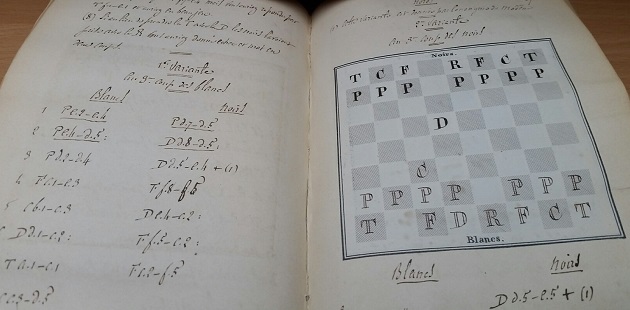
This is one of a large variety of items listed in our latest feature article, Chess Books and Magazines For Sale.

11083. Fischer and the FBI
The FBI Vault contains a 1966-67 file on Fischer’s passport requests for travel to Cuba.
11084. American chess masters
Olimpiu G. Urcan (Singapore) draws attention to a cartoon feature on pages 26-27 of the November-December 2018 Playboy: ‘American Chess Masters’ written by Brin-Jonathan Butler and illustrated by Nathan Gelgud.

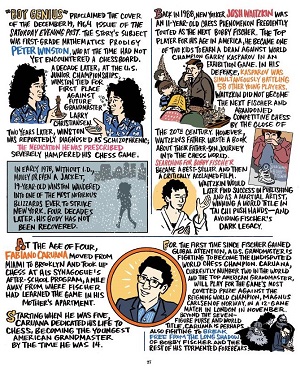
The left-hand section on Morphy refers to ‘a spooky child prodigy’ who later ‘traveled across Europe and toured royal courts ...’ Then comes this ‘Fun’:
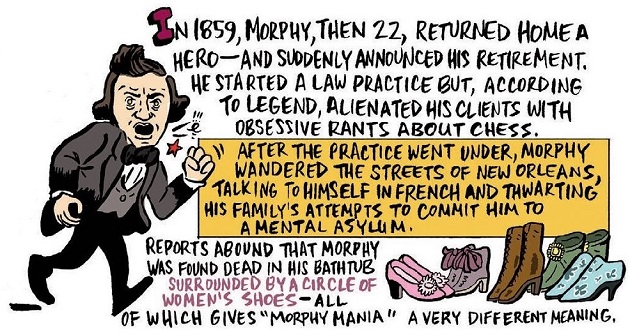
The treatment of Steinitz does not even attain the ‘according to legend’ and ‘reports abound that’ level:
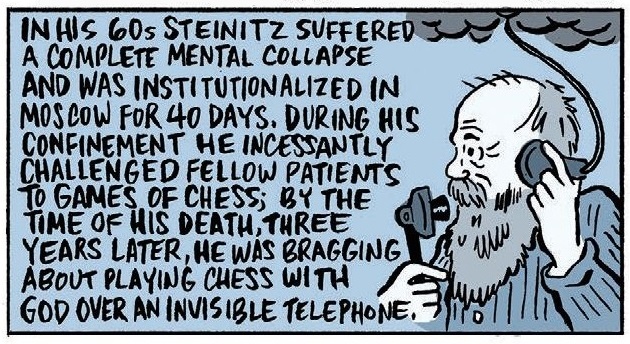
11085. Fischer film

Michael Clapham (Ipswich, England) has been watching the film by Friðrik Guðmundsson Me & Bobby Fischer, which is available on DVD:
‘It has over an hour of Fischer talking, in 2005, about such matters as his aborted match with Karpov, his time in prison, his views on Jews, and pre-arranged games.’
11086. P.N. Izmailov
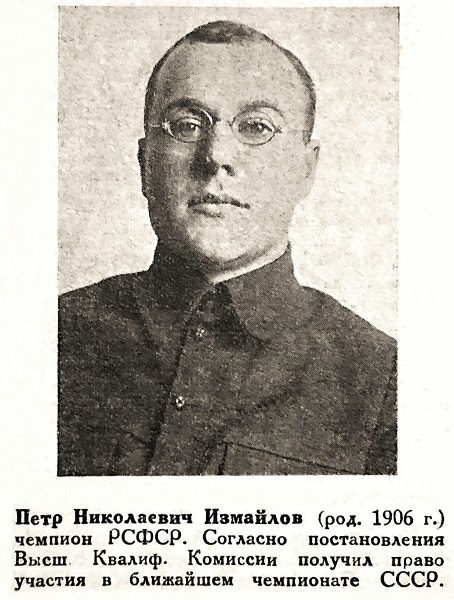
This photograph of Piotr Nikolaevich Izmailov (1906-37) comes from page 10 of the 1/1929 issue of Shakhmatny Listok and has been supplied by Eduardo Bauzá Mercére (New York, NY, USA).
A detailed biographical article by Sergei Grodzensky, published on pages 24-26 of 64, December 1990, related Izmailov’s arrest in 1936, execution in 1937 and rehabilitation in 1957:
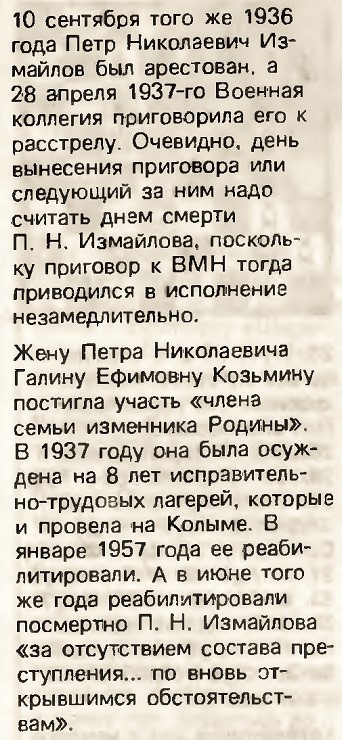
The 64 article has been forwarded by Vitaliy Yurchenko (Uhta, Russian Federation), who adds that there is further information about Izmailov on pages 28-44 of a book on Siberian chess: Сибирь шахматная by R. Kur, V. Neishtadt and K. Sukharev (Novosibirsk, 1995).
11087. William Winter and Lilliput
Eric Fisher (Hull, England) reports that he has three articles by William Winter in Lilliput (November 1949, June 1950 and November 1950) and asks whether there are any others. He has provided pages from the June 1950 and November 1950 issues.
11088. Chess shirts
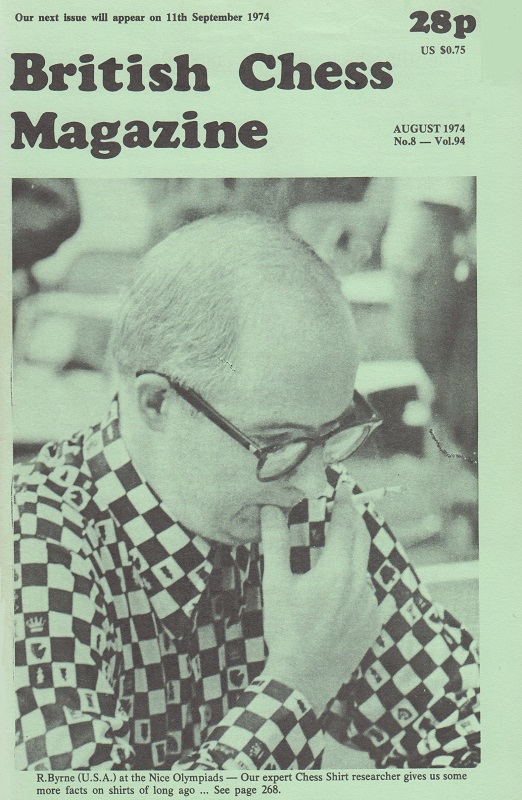
D.J. Morgan, the ‘expert Chess Shirt researcher’ mentioned in the caption, wrote on page 268:
‘F.M. Edge (a most untrustworthy writer where Staunton was concerned) states in his Morphy book that Staunton was so rabid about chess that he wore shirts with representations of the chess pieces on the breasts and tails.’
Edge’s exact words, on pages 151-152 of the New York edition of his book and page 133 of the London edition:
‘Staunton’s literary avocations now permit him but an hour or two weekly for chess, although formerly he lived in the London Divan, as Harrwitz in the Régence, and was so rabid about Caïssa that he actually wore shirts with kings, rooks, pawns, etc. printed over the bosoms and tails.’
‘It is just possible that he did’, added G.H.Diggle in D.J. Morgan’s column, pointing out these passages:

Chess Player’s Chronicle, 1847, page 68
Chess Player’s Chronicle, 1847, page 140
From page 254 of XIV. Schach-Olympiade Leipzig 1960, published by Sportverlag Berlin:

11089. Chess metaphors
Under the title ‘Journalistic Chess’ page 157 of the February 1922 Chess Amateur commented:
‘Judging by the continual references to chess, especially to chess strategy, in the daily papers, the average journalist is much fonder of using chess metaphors and images than he is acquainted with their real meaning.
In our contemporary, the Daily Mail, on 19 November, two contributors availed themselves of chess analogies with more success than is normal, though at least one “howler” was necessary evidently.
Mr H.G. Wells, in his remarkable papers on the Washington Conference, writes:

Mr A.E. Manning Foster in his usual Saturday article on bridge, in a book review, under the heading “Strategy at Auction Bridge”, writes:

The reader will be amused in spotting the obvious blunder in these quotations, excepting which, however, the allusions are unusually accurate.’
We have incorporated the relevant passages from the Daily Mail (on, respectively, pages 8 and 6 of the 19 November 1921 edition). The paragraph beginning ‘Auction bridge’ was omitted by the Chess Amateur.
11090. Adolf Anderssen
Pages 39 and 183 of the new book Neumann, Hirschfeld and Suhle by Hans Renette and Fabrizio Zavatarelli (C.N. 11090) have two rare portraits of Anderssen, from, respectively, an 1872 issue of the Illustrirte Zeitung and the Lothar Schmid Collection. The former picture is shown here courtesy of the co-authors:

11091. A Canadian chess film
C.N. 464 (see Chess Jottings) welcomed the film Jouer sa vie by Gilles Carle and Camille Coudari. It can be viewed online under its English title, The Great Chess Movie.
11092.
Buenos Aires Olympiad, 1939
From Eduardo Bauzá Mercére (New York, NY, USA):

Source: Crítica, 2 September 1939, page 11.
11093. Chess shirts (C.N. 11088)
Gerard Killoran (Ilkley, England) sends a cutting from page 15 of the Illustrated London News, 20 February 1847:
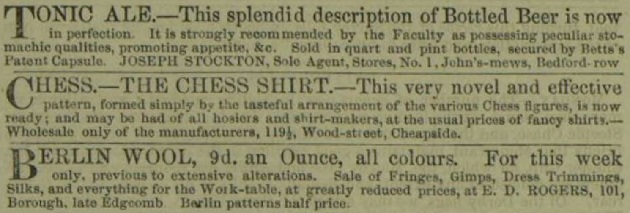
11094. Lasker v Tarrasch, 1908
Page 3 of The World Chess Championship: 1951 Botvinnik v Bronstein by William Winter and R.G. Wade (London, 1951):

Given that Lasker defeated Tarrasch +8 –3 =5, this account seems generous to Tarrasch. As regards the quality of play, James Mortimer expressed a different view on page 8 of the Daily Mail, 15 September 1908:

11095. Lasker v Capablanca, 1921
Why is it so hard to find photographs of the 1921 world championship match in Havana? There was no Cuban chess magazine at the time, and we have yet to locate pictures in the host country’s mainstream press.
11096. Fischer caricature (C.N.s 8721, 8724 & 8778)
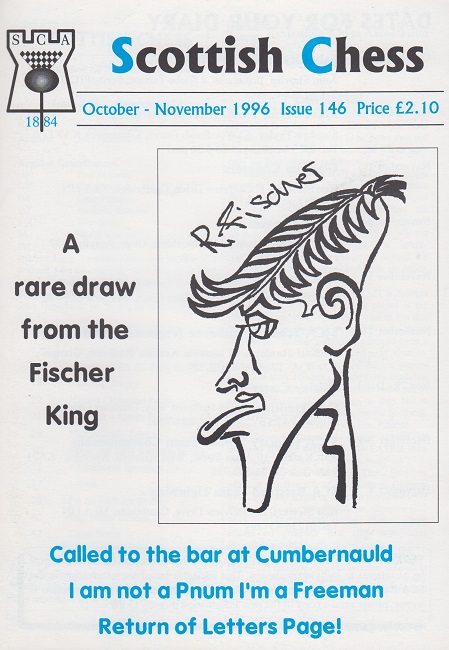
This caricature is often attributed to Fischer himself, but in C.N. 8724 a correspondent reported that the website of Marina Petric showed it as one of many by her late father, Berislav Petric. The link given in C.N. 8724 is no longer valid, and her new webpage does not currently include the Fischer drawing.
11097. Computer pairings
This cutting from page 1 of Chess Life, 5 September 1958 has been forwarded by Eduardo Bauzá Mercére (New York, NY, USA):

Which was the first open tournament where all the pairings were made by a computer?
11098. The Rossolimo Variation of the Sicilian Defence
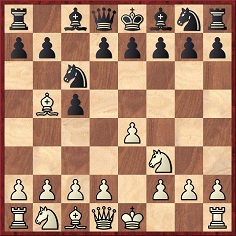
Position after 1 e4 c5 2 Nf3 Nc6 3 Bb5
Some initial historical jottings are offered on the Rossolimo Variation of the Sicilian Defence, played in the 2018 world championship match between Magnus Carlsen and Fabiano Caruana.
What cannot be given for now is a comprehensive explanation as to when Rossolimo’s name was attached to – or, indeed, detached from – the opening. Databases have relevant Rossolimo games from the late 1940s onwards, and the reference to ‘around 1940’ in The Oxford Companion to Chess by D. Hooper and K. Whyld (1984 and 1992 editions) has yet to be substantiated:

1984 edition, page 286
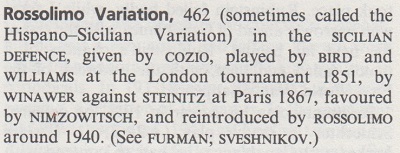
1992 edition, page 345
Annotating Rossolimo v Romanenko, Salzburg, 1948 on pages 647-648 of the October 1975 Chess Life & Review, Pal Benko wrote after 1 e4 c5 2 Nf3 Nc6 3 Bb5:
‘Rossolimo usually avoided normal Sicilian patterns, and the text was one of his favorites. Nimzowitsch played this against Gilg in 1927, but it was Rossolimo who, through his frequent use of it, made this system an effective and fully respectable weapon. For a time, it was known as “the Rossolimo Variation” and is today commonly seen with colors reversed in the English Opening’ [as in the game Barry v Rossolimo, World Open, New York, 1975 which Benko annotated on page 648].
Page 181 of the Dictionnaire des échecs by F. Le Lionnais and E. Maget (Paris, 1967 and 1974) called 1 e4 c5 2 Nf3 Nc6 3 Bb5 ‘L’attaque hispano-sicilienne’, and had the following on page 340:
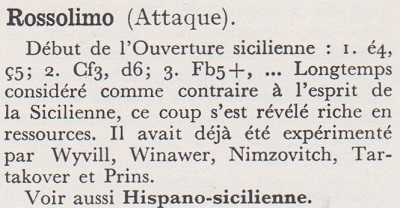
C.N. 1230 drew attention to the obvious inaccuracy of this text on page 1 of The Anti-Sicilian: 3 Bb5(+) by Y. Razuvayez and A. Matsukevitch (London, 1984):

Although the Companion also mentioned Winawer v Steinitz, Paris, 1867, that game began 1 e4 c5 2 Nf3 e6 3 Nc3 Nc6 4 Bb5, as shown on pages 182-183 of the tournament book.
When were the moves 1 e4 c5 2 Nf3 Nc6 3 Bb5 first played? The earliest game that we have found is on pages 327-328 of the Chess Player’s Chronicle, 1845 (volume six), a win by Elijah Williams against John Withers, played (according to page 325) ‘very recently at Bristol’:
1 e4 c5 2 Nf3 Nc6 3 Bb5 Nd4 4 Nxd4 cxd4 5 O-O e5 6 d3 Qb6 7 Bc4 d6 8 f4 Be6 9 Bxe6 fxe6 10 fxe5 O-O-O 11 Rf7 dxe5 12 Bg5 Nf6 13 Nd2 h6 14 Nc4 Qb5 15 Bxf6 gxf6 16 Qg4 f5 17 exf5 h5 18 Qg6 Rh6 19 Rxf8 Rxg6 20 Nd6+ Kd7 21 Rxd8+ Kxd8 22 Nxb5 and wins.

Source: XIV. Schach-Olympiade Leipzig 1960, page 192.
11099. The graves of Capablanca and Alekhine
Cătălin Duminecioiu (Bucharest) reports that he has photographed the graves of Capablanca (November 2014) and Alekhine (summer 2016):

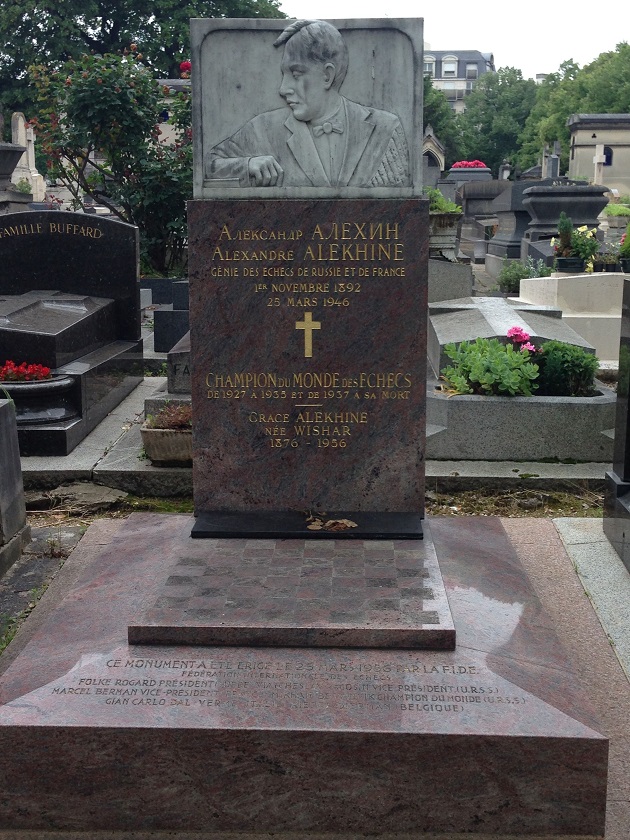
11100. Fischer caricature (C.N.s 8721, 8724, 8778 & 11096)
Marina Petric (Austin, TX, USA) informs us that her father, Berislav Petric, drew a set of chess caricatures in Belgrade and asked the players concerned, including Fischer, to sign them. She has provided the two pictures below:
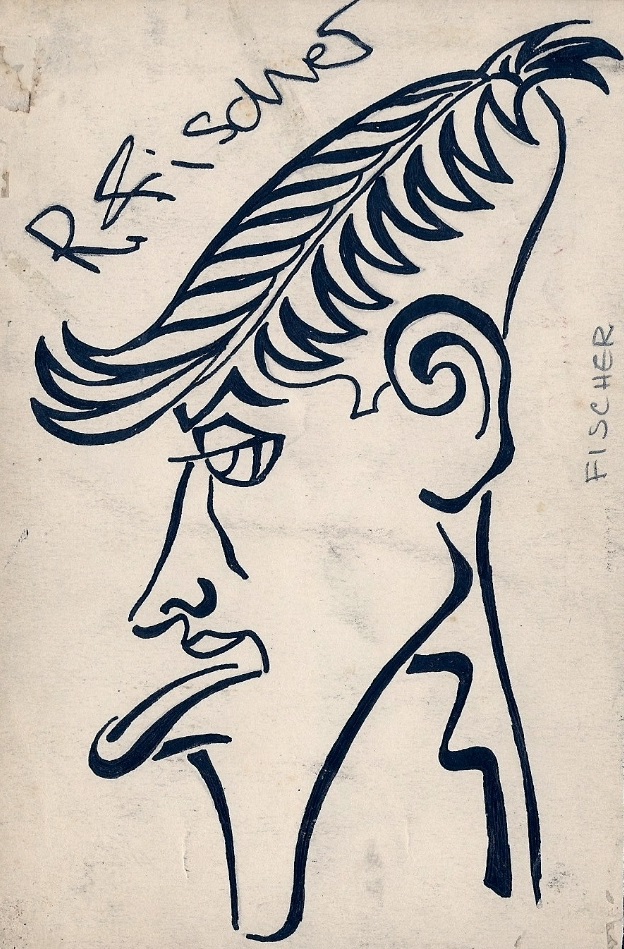
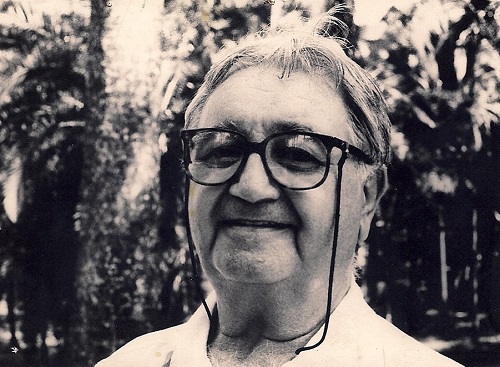
Berislav Petric
At our request, Marina Petric has added that her father was born in Sarajevo on 3 May 1929. After graduating in architecture, he emigrated to Brazil in 1964, and died in Rio de Janeiro on 8 May 1998.
11101. Miss Cotton
From Rod Edwards (Victoria, BC, Canada):
‘In C.N. 6627 you gave the results of the Ladies’ tournament at San Remo, 1911, with “Miss Selma Cotton (London)” coming second. There was a Helene Cotton (or Charlotte Helene Cotton-Meirchin) who was active for many years in England and was at Meran, 1924 (C.N. 4838). Page 147 of the April 1911 BCM gave the name of the woman at San Remo, 1911 only as “Miss Cotton (London)”. I am wondering where the name “Selma” is to be found, and whether it may have been Helene Cotton who played at San Remo, 1911 after all.’
The name ‘Selma Cotton’ appeared in connection with San Remo, 1911 in the Deutsches Wochenschach (5 March 1911, page 86 and 26 March 1911, page 119) and, as shown below, on page 109 of La Stratégie, March 1911:

11102. The parentage of John Cochrane
John Townsend (Wokingham, England) writes:
‘The Inner Temple Admissions Database indicates that John Cochrane was admitted to the Inner Temple on 13 May 1819, the third son of the Honourable John Cochrane, of Edinburgh, that he was called to the Bar on 29 June 1824, and that he died on 2 March 1878.
“Honourable” was applied to untitled children of nobility. In the case of Cochrane’s father, the Honourable John Cochrane (1750-1801) was a son of Thomas Cochrane, the eighth Earl of Dundonald. He was a much-travelled man, and his children were born to several women. He was not married until 7 May 1800, when the marriage register of St Marylebone shows that he tied the knot as a bachelor with Selina Fitzroy Birch, a spinster, of Pinner, Middlesex. Neither of them lived long afterwards, and they left no surviving issue. Selina made her will (National Archives, PROB 11/1383/378) on 24 July 1801, and it was proved on 22 December 1802. Her husband was buried at St James’s Piccadilly on 26 October 1801. A short death notice in the Morning Post (29 October 1801, page 4) mentioned that he had died on 21 October at his house in Harley Street, Cavendish Square, “two months after the death of his beloved wife and infant son”.
The will of the Honourable John Cochrane (National Archives, PROB 11/1407/25) was written on 27 September 1801, while he was living in Harley Street, but was not proved until 6 April 1804. He named three (illegitimate) sons and a daughter (Angelique Cochrane). The first two sons were Nathaniel Day Cochrane and James Johnston [sic] Cochrane. Since the third son was John Cochrane, the information corroborates that obtained from the Inner Temple Admissions Database (see above), and that makes it possible to identify the chessplayer as the recipient of the following bequest:
“I give and bequeath unto John Cochrane the son of Margaret McDougal now living at Newhaven near Leith the like sum of one thousand pounds.”
Newhaven lies on the coast about two miles to the north of Edinburgh. It appears from this bequest that the chessplayer spent at least some of his early childhood there. Nothing is otherwise known of his mother, Margaret McDougal, although there is ample scope for further research, and especially if she left a will.
In 1826 John Cochrane received another gift of £1,000, this time from the brother of the Honourable John Cochrane, the Honourable Basil Cochrane, whose will (National Archives, PROB 11/1718/389) contained this:
“And I do hereby give and bequeath the sum of one thousand pounds Sterling to John Cochrane also the reputed Son of my said late Brother the Honourable John Cochrane.”
This immediately follows bequests to Nathaniel Day Cochrane and James Johnstone [sic] Cochrane, and therefore underlines the status of John Cochrane as the third son. The will was made on 7 June 1824, and probate was granted in London on 16 November 1826. The first two sons rose to senior positions in the navy and army respectively, while John Cochrane became a barrister.
Also to be found in the National Archives, and not so far examined, is a “probate inventory, or declaration, of the estate, with account”, of Hon. John Cochrane, deceased, of Harley Street, St Marylebone, dated March 1810 (PROB 31/1037/285).
The age of John Cochrane the chessplayer was given as 72 in the 1871 census (National Archives, RG 10/165, folio 48), his place of birth being entered as Edinburgh. At that time, he was living as a lodger in a boarding house at 32 Seymour Street, Marylebone, described as “Barrister in Practice”. In the same house were two women by the name of Emily Cochrane; their ages were given as “60” and “30-40”.
Cochrane’s age at the time of his death in the March quarter of 1878 was given as 78 in the death indexes at the General Register Office (ref. Marylebone, vol. 1A, page 444).
With that information it may be possible to find a baptism (or birth) record for the chessplayer during the approximate period 1798-1800, perhaps in Edinburgh, Newhaven or Leith. Such a search would be assisted by the knowledge that the mother was Margaret McDougal and the father the Honourable John Cochrane.
Cochrane was a most generous subscriber to the 1851 London tournament, as can be seen from pages xxxi and lix of Staunton’s The Chess Tournament (1852). In addition to his own donation of £20, he must also have played some part in a contribution of £100 in the name of the Calcutta Chess Club, of which he was the President. However, he was not a rich man when he died. His own will is referenced in the National Probate Calendar, which shows that he died on 2 March 1878 and that his personal estate was valued at under £200; the sole executrix was his niece, Emily Cochrane, a spinster, and the address of both was entered as 12 Bryanston Street, (which, incidentally, differs from the 6 Bryanston Street given for Cochrane’s death in the Inner Temple Admissions Database.) This Emily Cochrane was an illegitimate daughter of Nathaniel Day Cochrane, and was born on 13 October 1825, according to her baptism entry on 21 February 1828 in the parish register of St Marylebone.’
11103.
Another Fischer photograph
From the plate section of International Championship Chess by B. Kažić (London, 1974):
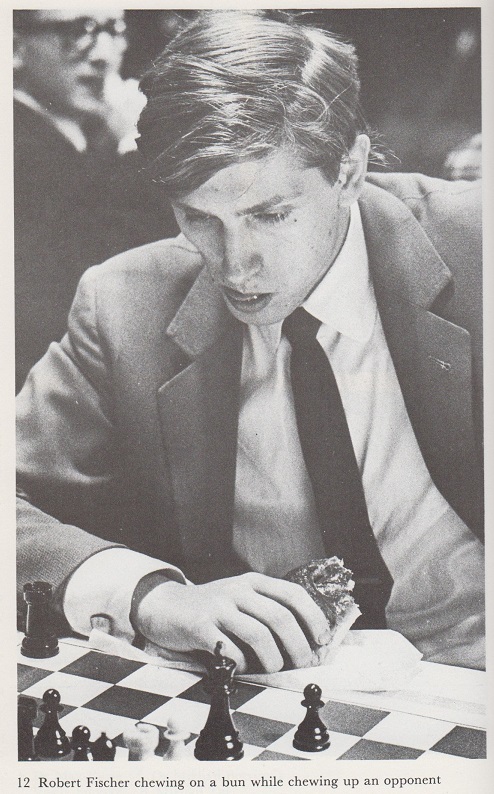
The caption might have added the identity of Fischer’s chewee: William G. Addison. The position shows the end of their game in round seven of the 1963-64 US Championship, New York.
11104. Miss Cotton (C.N. 11101)
Gerard Killoran (Ilkley, England) submits a game from O.C. Müller’s column on page 8 of The Globe, 12 October 1912:
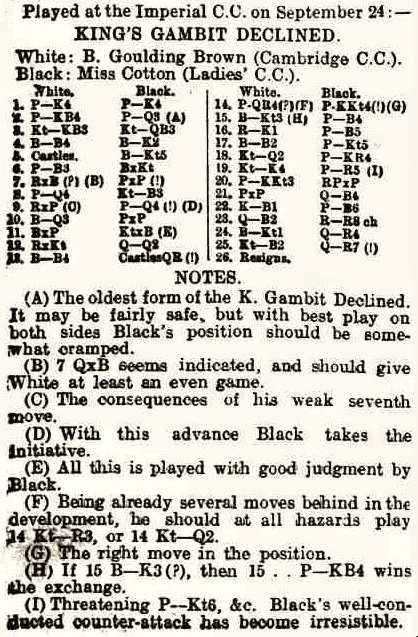
1 e4 e5 2 f4 d6 3 Nf3 Nc6 4 Bc4 Be7 5 O-O Bg4 6 c3 Bxf3 7 Rxf3 exf4 8 d4 Nf6 9 Rxf4 d5 10 Bd3 dxe4 11 Bxe4 Nxe4 12 Rxe4 Qd7 13 Bf4 O-O-O 14 a4 g5 15 Bg3 f5 16 Re1 f4 17 Bf2 g4 18 Nd2 h5 19 Ne4 h4
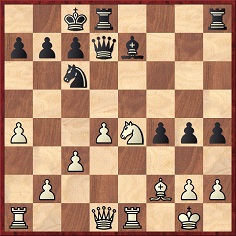
20 g3 hxg3 21 hxg3 Qf5 22 Kf1 f3 23 Qc2 Rh1+ 24 Bg1 Qh5 25 Nf2 Qh2 26 White resigns.
11105. Faster or easier wins
Annotators and chroniclers often have difficulty deciding to what extent players who miss faster or easier wins should have such lapses pointed out. To illustrate the theme, we present a range of observations in books by Irving Chernev.

Combinations The Heart of Chess (New York, 1960), page 37
Denker won quickly with 34 Qd5 Kf8 35 Rxg7. The artist/butcher remark is reminiscent of an observation by Emanuel Lasker on page 68 of the Chess Player’s Scrap Book, May 1907 in connection with the game Morphy v the Duke and Count.
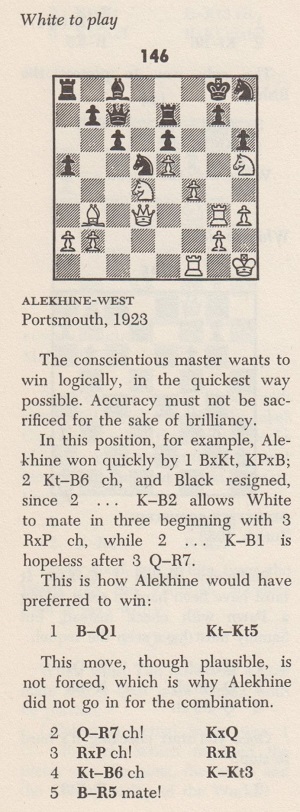
Combinations The Heart of Chess (New York, 1960), page 74


Logical Chess Move by Move, various editions, Game 27 (Chekhover v Rudakovsky, Moscow, 1945)
The almost identical text was on pages 193-194 of The Most Instructive Games of Chess Ever Played (New York, 1965).
Another example is Paulsen v Morphy, New York, 1857:
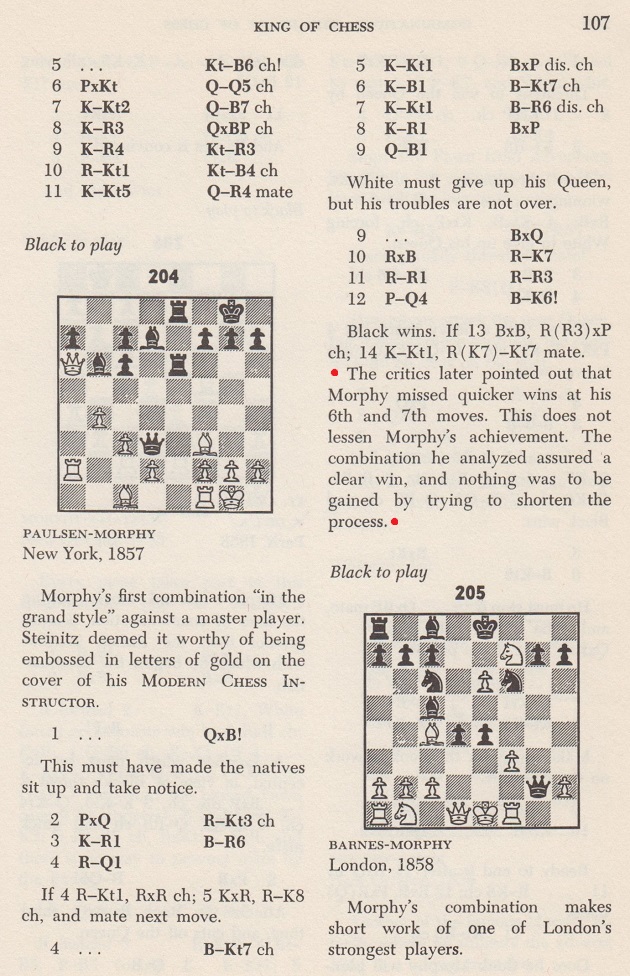
Combinations The Heart of Chess (New York, 1960)
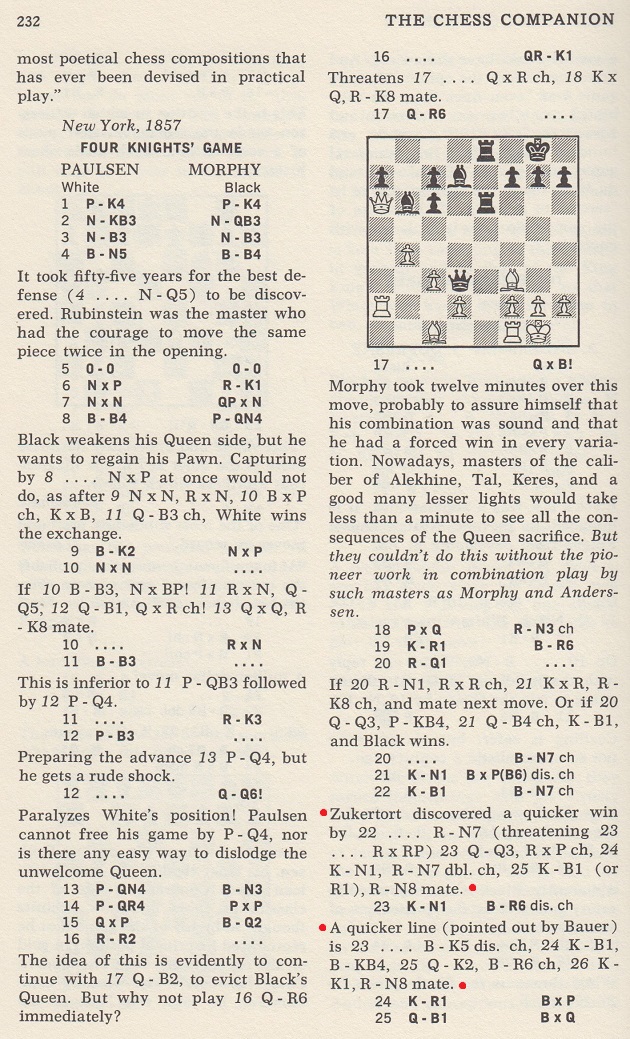
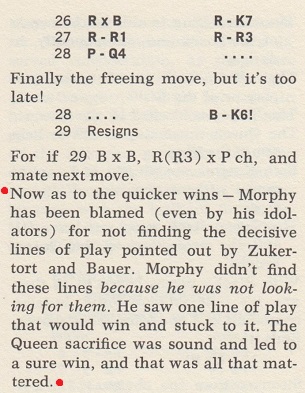
The Chess Companion
(New York, 1968), pages 232-233
The next position comes from a famous brilliancy by Capablanca (White) against Juan Corzo, Havana, 1901:
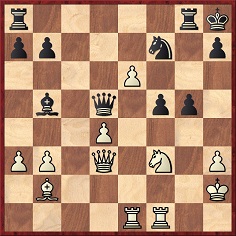

The Golden Dozen (Oxford, 1976), page 284
Virtually the identical text had appeared on pages 175-176 of The Chess Companion.
The ‘commentator’ in question was Fred Reinfeld, in The Immortal Games of Capablanca (New York, 1942). In My Chess Career (London, 1920) Capablanca wrote:
‘Today, very likely, I would simply have played Q-Q2 and won also, but at the time I could not resist the temptation of sacrificing the queen. At any rate, the text move was the only continuation which I had in mind when I played P-K6.’
From later in the same game, where Capablanca played 46 Kf2:
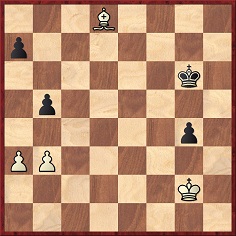


Capablanca’s Best Chess Endings (Oxford, 1978), page 7
Neither Capablanca nor Reinfeld mentioned 46 Kg3. On pages 228-230 of Combinations The Heart of Chess Chernev made no adverse comment on either 29 Qxb5 or 46 Kf2.
A final illustration of the difficulty of avoiding inconsistency comes from page 255 of The Chess Companion, in the conclusion to D. Byrne v Fischer, New York, 1956:
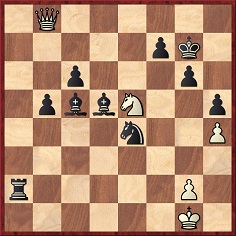

Our feature article on the game shows that the future world champion’s own small book, Bobby Fischer’s Games of Chess, made no reference to the faster mates available at move 36 (...Rf2+) and at move 37 (...Re2+). Those lines would have given mate just one move earlier, and their noteworthiness is a matter of opinion. It is curious, though, that Chernev mentioned only one of the two.
11106. John Cochrane (C.N. 11102)
Shortly after John Cochrane’s death, a tribute by I.O. Howard Taylor was published on page 2 of the Hartford Weekly Times, 4 April 1878. It was reproduced on pages 30-32 of the American Chess Journal, April 1878 and, thanks to the Cleveland Public Library, we give below the front cover and the frontispiece portrait of Cochrane in addition to the letter itself:
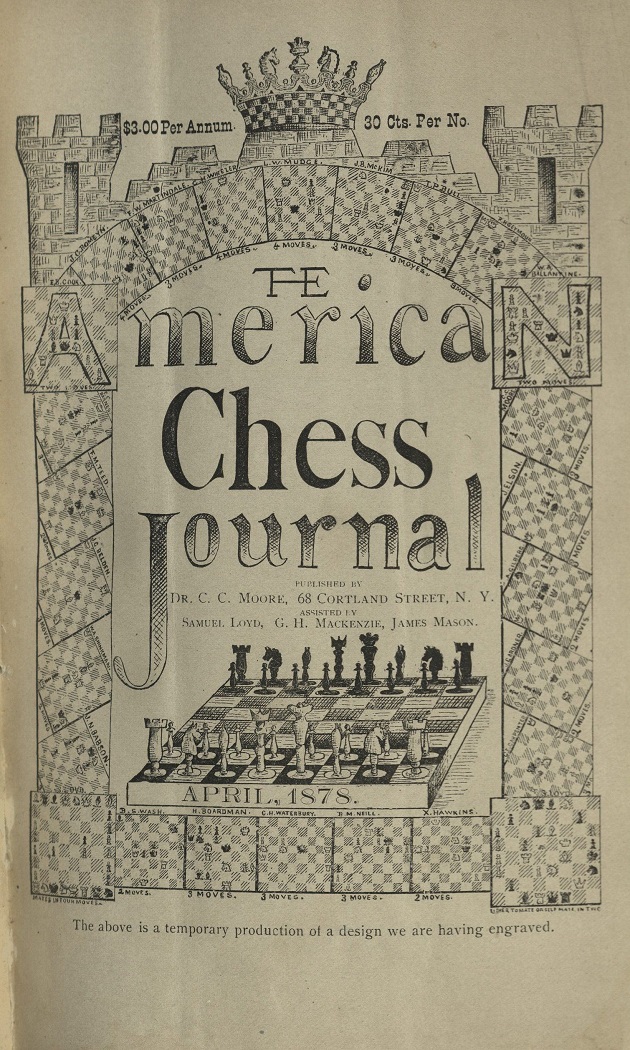
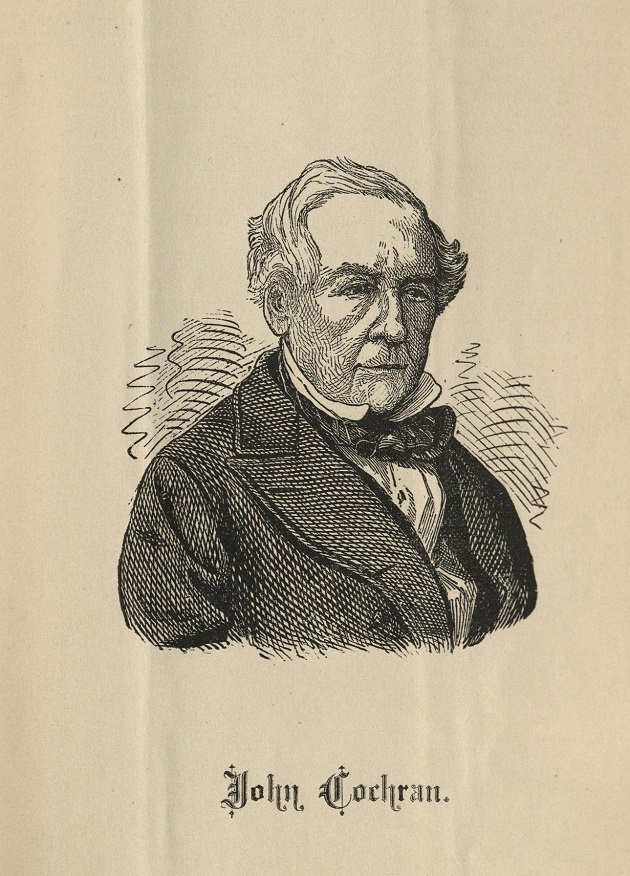

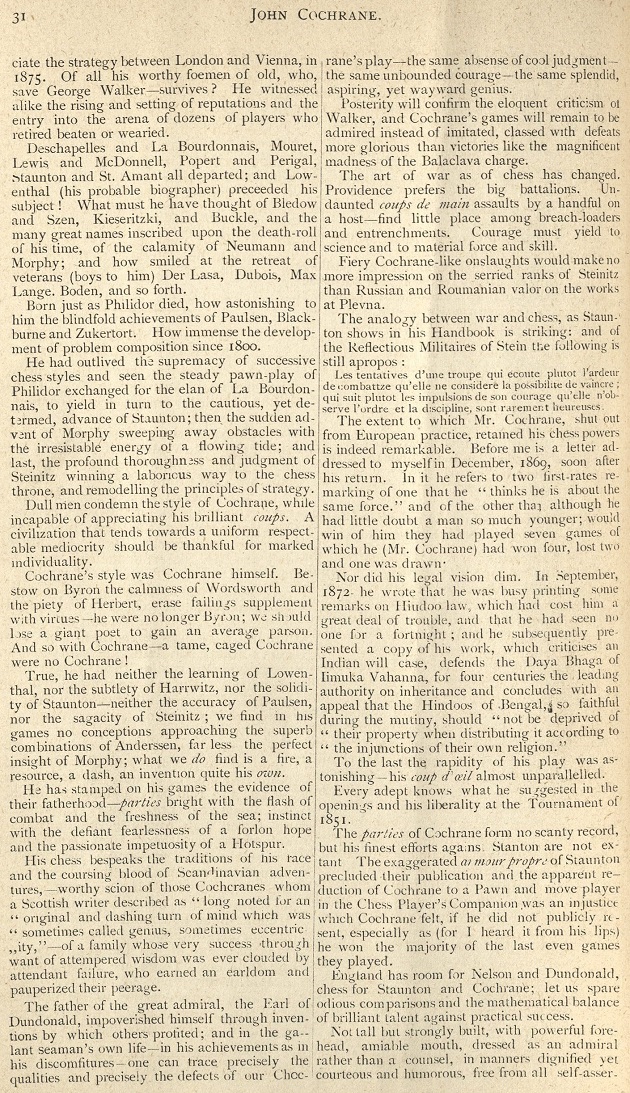

11107. Miss Cotton (C.N.s 11101 & 11104)
The obituary on page 92 of the March 1929 BCM which was referred to in C.N. 4838:

From John Townsend (Wokingham, England):
‘The National Probate Calendar has a 1929 entry for Charlotte Helena Minchin Cotton, of 2 Chester Terrace, Regent’s Park, Middlesex, spinster, who died on 9 January 1929 at 7 Osnaburgh Terrace, Regent’s Park. Probate was granted in London on 20 February to Mary Rose Small, widow, and Reginald Waring Cotton, electrician, the effects amounting to £3,631 18s. 9d.
The death indexes at the General Register Office contain an entry in the March quarter of 1929 for Helena C.M. Cotton (ref. Pancras, vol. 1b, page 4), the age being given as 53.
There is a corresponding birth entry for the June quarter of 1875 for Charlotte Helena M. Cotton in the registration district of Tiverton (Devon) (ref. vol. 5b, page 431).’
11108. Kurt Richter
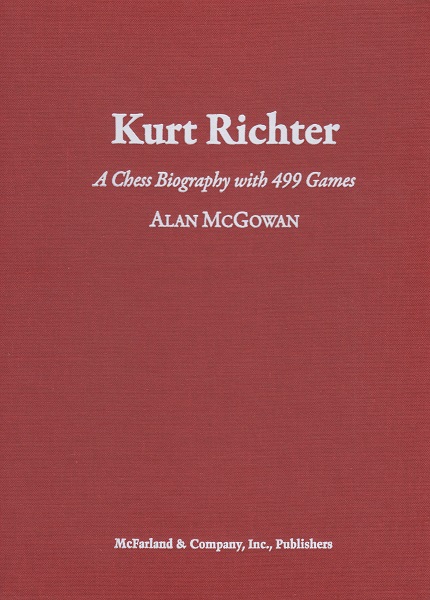
No chess enthusiast should miss Kurt Richter by Alan McGowan. It is brilliant.
11109. Kurt Lüdecke (C.N.s 3449, 3453, 3456, 3541 & 3761)
Two photographs of Kurt G.W. Lüdecke with Adolf Hitler were shown in C.N.s 3453 and 3761. They were from a set of six in the plate section of Lüdecke’s book I Knew Hitler (London, 1938), between pages 472 and 473:

11110. Leipzig, 1960
Page 180 of XIV. Schach-Olympiade Leipzig 1960 has this photograph of the little-known player Anne Marie Renoy-Chevrier of Monaco:

11111. Miss Cotton (C.N.s 11101, 11104 & 11107)
The items below from L’Italia Scacchistica have been forwarded by the Cleveland Public Library:
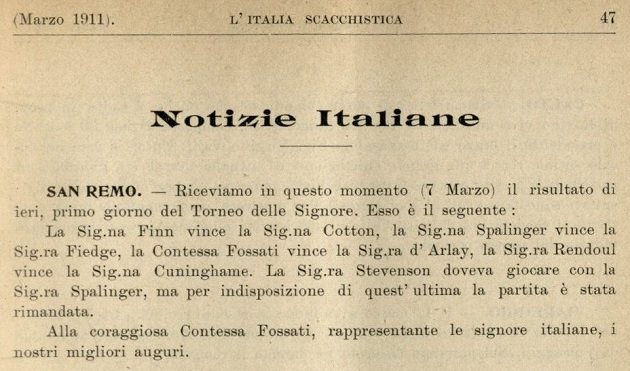
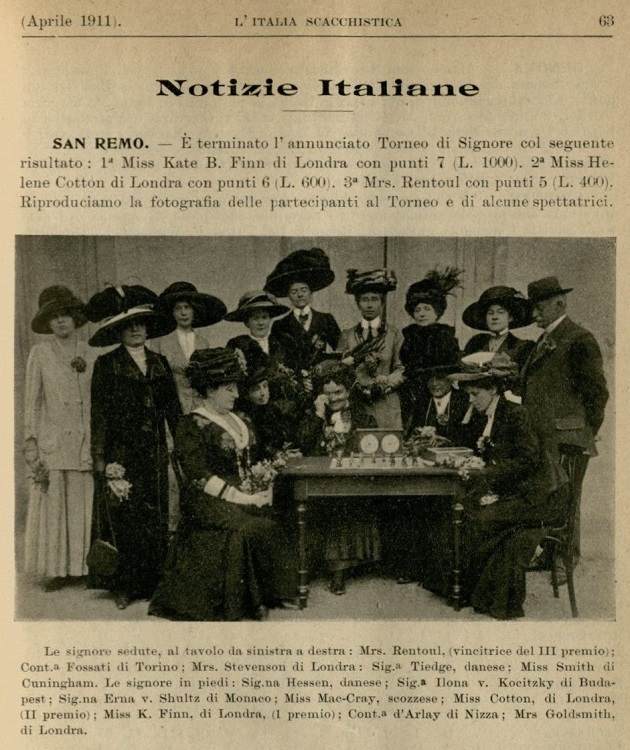
11112. When in doubt ... (C.N.s 10422 & 10443)
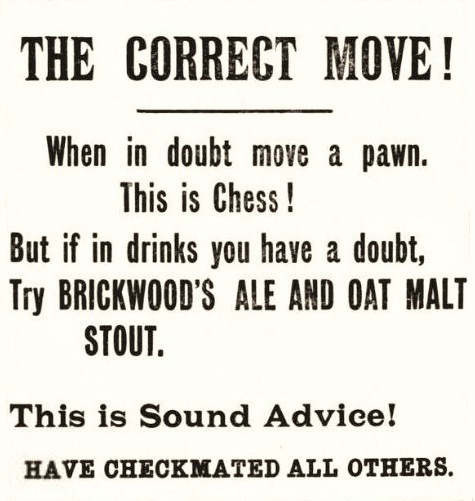
Portsmouth Evening News, 17 September 1910, page 1
Earlier that year, a more familiar version of the ‘when in doubt ...’ phrase had appeared in note (g) to a game between F.D. Yates and G.A. Thomas on page 15 of the Hereford Times, 16 April 1910:

1 e4 e6 2 d4 d5 3 Nc3 dxe4 4 Nxe4 Nd7 5 Nf3 Ngf6 6 Bd3 Nxe4 7 Bxe4 Nf6 8 Bd3 Be7 9 O-O O-O 10 b3 b6 11 c4 Bb7 12 Bb2 Nd7 13 Re1 Bf6 14 Re3 Re8 15 Qe2 Bxf3 16 Rxf3 e5 17 Qc2 exd4 18 Bxh7+ Kf8 19 Be4 Rb8 20 Bd5 c5 21 Kf1 Ne5 22 Rh3 Qd6 23 Qf5 Ng6 24 Rd1 Qe5 25 Qf3 Kg8 26 Rh5 Qf4 27 Qh3 Re3 28 g3 Bh4
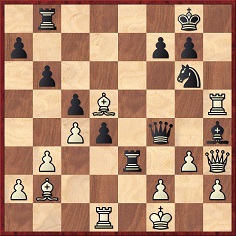
29 Rf5 Resigns.
Some further citations:
- ‘When in doubt, move the king.’
David A. Mitchell, page 37 of Mitchell’s Guide to the Game of Chess (Philadelphia, 1915).
- ‘When in doubt ... move a knight!’
Heading to a feature on the openings, page 279 of Chess Review, December 1938.
- ‘When in doubt, move the king!’
Article on endgames by Jack W. Collins, page 26 of Chess Review, December 1947.
- ‘The old adage, “When in doubt, castle” gives spurious sanction to a special instance of the generally sounder guide for opening play, “When in doubt, develop”.’
Robertson Sillars, page 112 of Chess Life & Review, February 1974.
- ‘This Larsenesque move (when in doubt, advance your rooks’ pawns!) is not as silly as it looks.’
John Watson, page 100 of Secrets of Modern Chess Strategy (London, 1998).
11113. FIDE federations
Dylan McClain (Richmond, IN, USA) asks how many federations were members of FIDE at the beginning and at the end of each President’s tenure.
Ideally, we wish to go further, with the running total of members throughout the Federation’s history. Do readers know whether such a list already exists?
11114. Birdie Reeve
Ulrich Schimke (Cologne, Germany) provides further newspaper reports on Birdie Reeve:
- Vaudeville News and New York Star, 16 July 1926, page 12:
‘Little Birdie Reeve is back again, playing chess with the aplomb and confidence of an old chessplayer, and giving some of our best players a real tussle, though the young lady is only 16 years old. It is a treat to watch her on the mezzanine floor of the NVA Club.’
- Syracuse Journal, 28 July 1926, page 8:
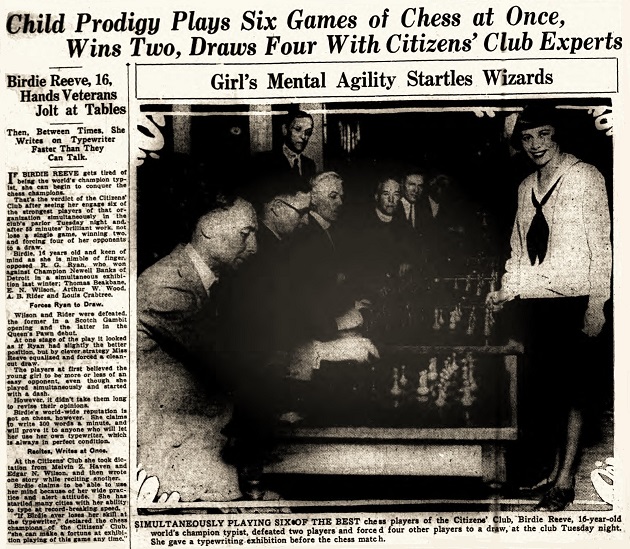
- Vaudeville News and New York Star, 30 April 1927, page 23:
‘Birdie Reeve defeated Theodore Roberts at chess on Sunday evening, 17 April at the NVA Club, NYC. Little Miss Reeve is a wonder child. She is not only a renowned chess and checker player, but a lexicographer and champion typist also.’
- Cohoes American, 24 February 1928, page 10:
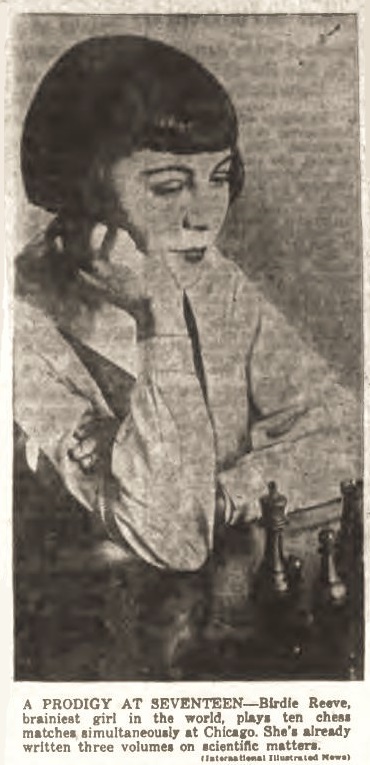
- Brooklyn Daily Eagle, 13 December 1928, page A9:
Under the heading ‘Planning Chess Tournament During Chicago World Fair; Federation Has Election’, Hermann Helms reported:
‘Directors of the National Federation of the ensuing year were elected at the annual business meeting held at the City Club of Chicago ... Immediately after the directors’ meeting Edward Lasker played 20 games simultaneously, including one blindfold. He won 15, drew four and lost one to Birdie Reeve.’
- Vaudeville News and New York Star, January 1929, page 12:
‘Miss Birdie Reeve[s], of the NVA Chess Club, has achieved some fame and received considerable publicity recently because of her ability at chess. Immediately after the National Chess Federation annual meeting in Chicago recently, Edward Lasker, one of America’s best chessplayers, played 20 games simultaneously. He won 15, drew four and lost one. The only game he lost was with Birdie Reeve[s], who is now playing vaudeville in the Chicago territory.’
- Brooklyn Daily Eagle, 20 July 1933, page 2:
‘Miss Virginia Sheffield, woman champion of the Illinois State Chess Association, ... gained her title only recently in a tournament at the City Club in which she scored 2½-½. Mrs H.E. Redding of Oak Park was placed second with 2-1, ahead of Birdie Reeve, 1½-1½. Miss Lambissi was a contender.’
11115. Belgrade, 1970
Rudy Bloemhard (Apeldoorn, the Netherlands) has shown us, from his autograph collection, this card signed during the 1970 USSR v the Rest of the World match in Belgrade:
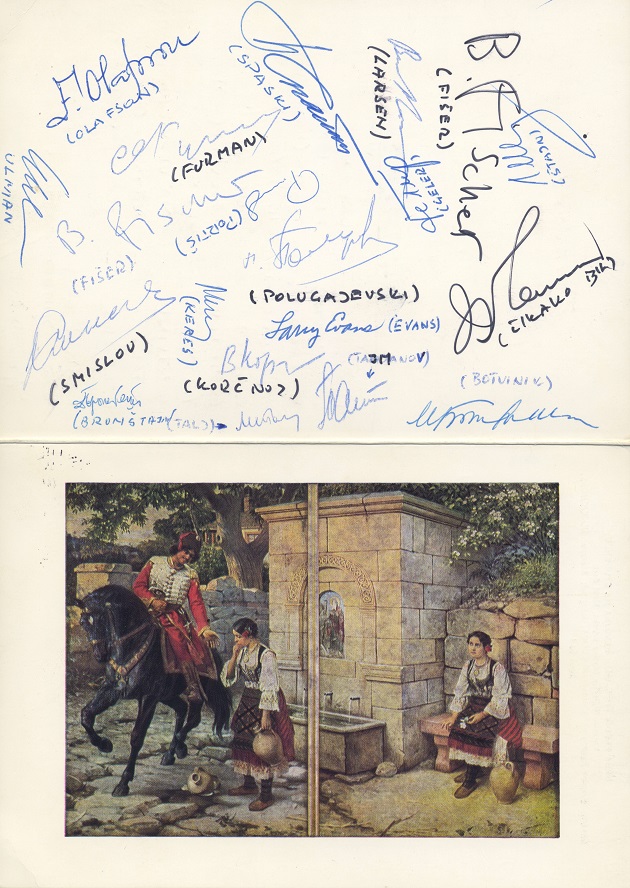
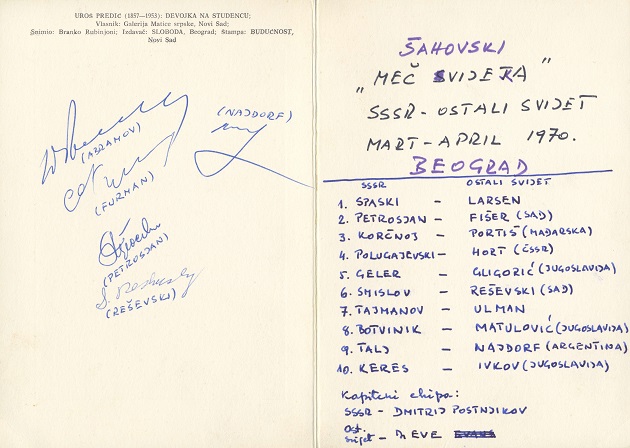
Our correspondent is intrigued by one signature in particular:
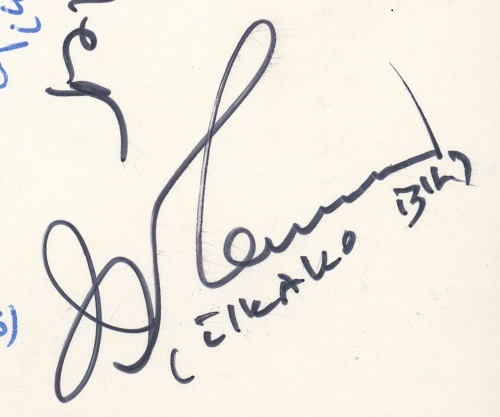
11116. Under-water chess
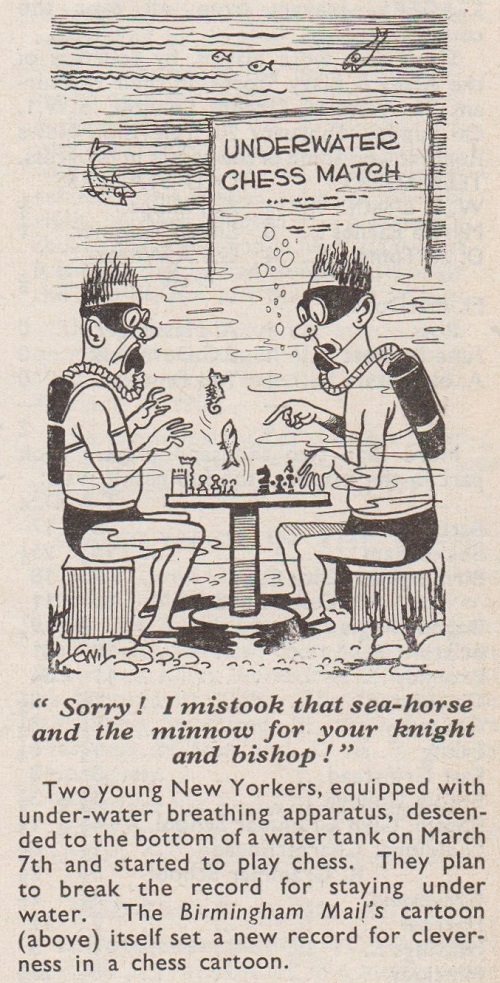
CHESS, 19 March 1955, page 255
Three years later the magazine briefly reported on an announcement by John E. Almond of San Francisco of the ‘very first world under-water chess championship’. See C.N. 3237 on page 125 of Chess Facts and Fables.
11117. A large chess display
Tom Braunlich (Broken Arrow, OK, USA) has found this report on page 3 of the Daily Chieftain, 26 May 1899:
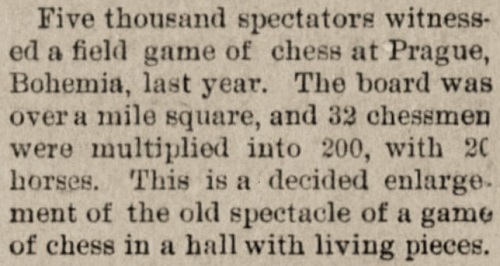
11118. The Mozart of Chess
‘Bobby Fischer: The Mozart of Chess’ was the heading of the chapter about him on pages 366-371 of The Jew in American Sports by Harold U. Ribalow (New York, 1959):
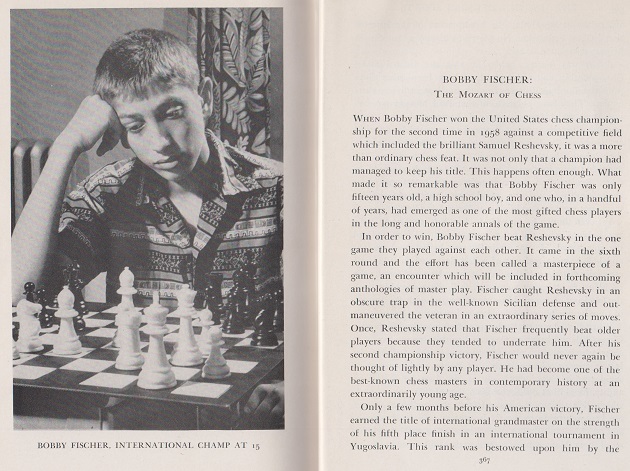
The chapter took its title from Harold C. Schonberg’s New York Times article of the previous year which is referred to in our feature article ‘The Mozart of Chess’.
11119. Lasker and Reshevsky
The preceding chapters of the Ribalow book mentioned in C.N. 11118 were on Emanuel Lasker (pages 344-354) and Samuel Reshevsky (pages 357-364). From page 344:
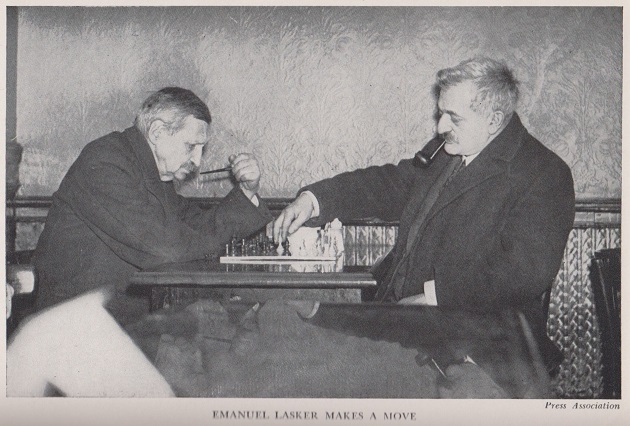
See too C.N. 3736. Who was Lasker’s opponent?
11120.
The number of chessplayers
An addition to How Many People Play Chess? comes from page 379 of CHESS, 18 June 1955:
‘A correspondent queries the statement in a recent Reader’s Digest that there are a hundred million chessplayers in the world. We should give 20 million as a more reasonable figure.’
11121. Ceremonial opening moves
Martin Sims (Upper Hutt, New Zealand) asks when the custom arose of the ceremonial first move for White being played by a ‘celebrity’, and whether any chess regulations are applicable to the practice.

This photograph from page 5 of the Illustrated London News, 5 January 1963 was given in C.N. 9020. Our correspondent remarks that a very similar shot of Sir Arthur Bliss and Vassily Smyslov is on page 183 of The World of Chess by Anthony Saidy and Norman Lessing (New York, 1974).
Addition: see too our feature article on Jacob Bronowski.
11122. Comins Mansfield’s letter to Adolf Hitler
Drawing attention to his article about Comins Mansfield on the website of the British Chess Problem Society, Michael McDowell (Westcliff-on-sea, England) sends us an extract from pages 13-14 of Comins Mansfield MBE: Chess Problems of a Grandmaster by Barry Barnes (Sutton, 1976):
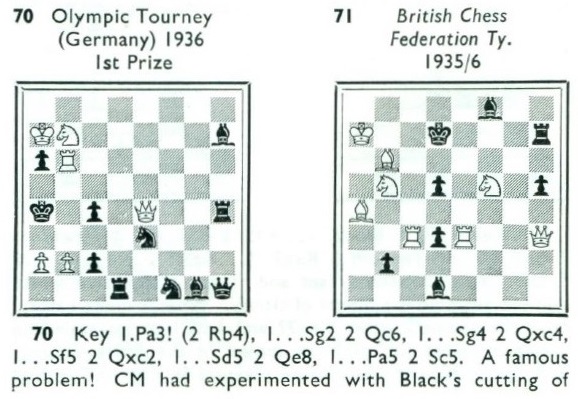

| First column | << previous | Archives [172] | next >> | Current column |
Copyright: Edward Winter. All rights reserved.